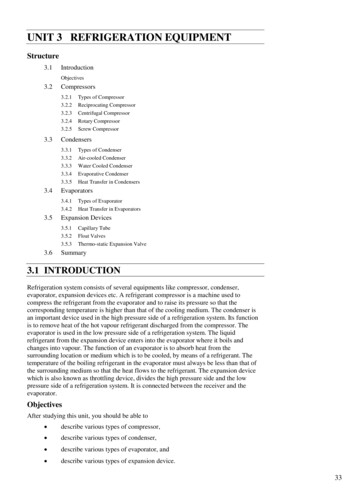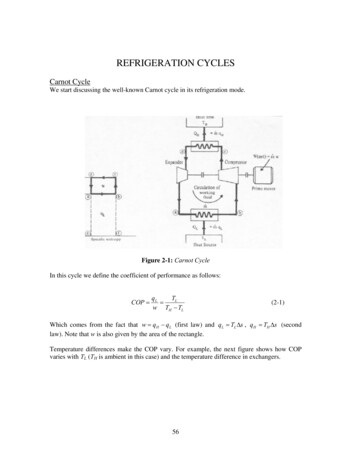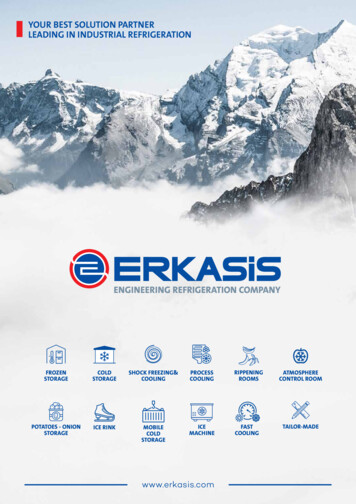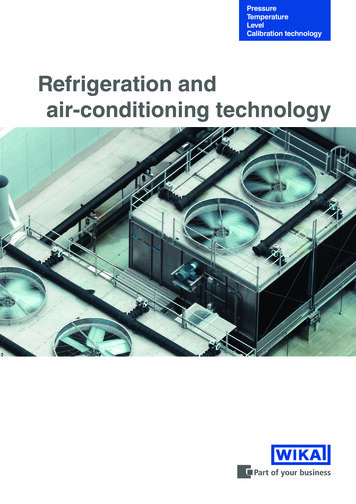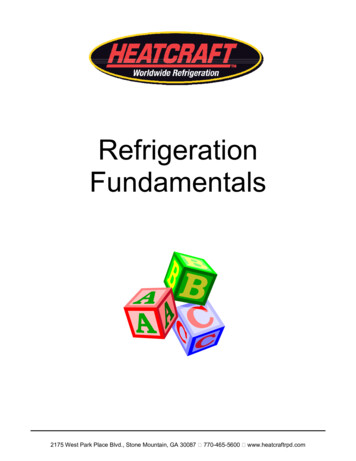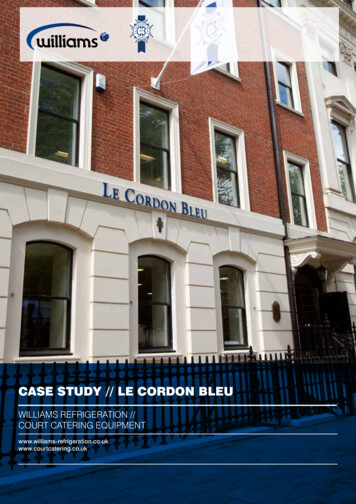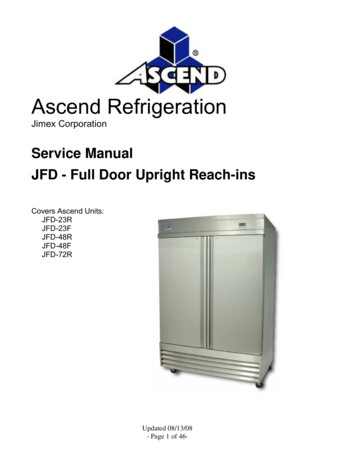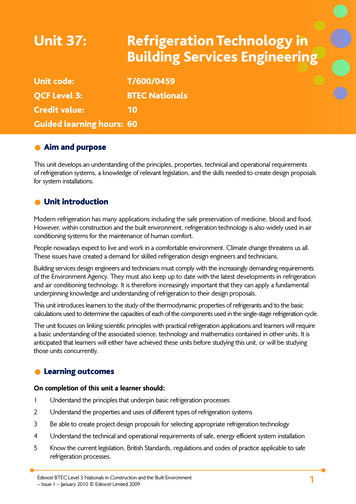
Transcription
Unit 37:Refrigeration Technology inBuilding Services EngineeringUnit code:T/600/0459QCF Level 3:BTEC NationalsCredit value:10Guided learning hours: 60Aim and purposeThis unit develops an understanding of the principles, properties, technical and operational requirementsof refrigeration systems, a knowledge of relevant legislation, and the skills needed to create design proposalsfor system installations.Unit introductionModern refrigeration has many applications including the safe preservation of medicine, blood and food.However, within construction and the built environment, refrigeration technology is also widely used in airconditioning systems for the maintenance of human comfort.People nowadays expect to live and work in a comfortable environment. Climate change threatens us all.These issues have created a demand for skilled refrigeration design engineers and technicians.Building services design engineers and technicians must comply with the increasingly demanding requirementsof the Environment Agency. They must also keep up to date with the latest developments in refrigerationand air conditioning technology. It is therefore increasingly important that they can apply a fundamentalunderpinning knowledge and understanding of refrigeration to their design proposals.This unit introduces learners to the study of the thermodynamic properties of refrigerants and to the basiccalculations used to determine the capacities of each of the components used in the single-stage refrigeration cycle.The unit focuses on linking scientific principles with practical refrigeration applications and learners will requirea basic understanding of the associated science, technology and mathematics contained in other units. It isanticipated that learners will either have achieved these units before studying this unit, or will be studyingthose units concurrently.Learning outcomesOn completion of this unit a learner should:1Understand the principles that underpin basic refrigeration processes2Understand the properties and uses of different types of refrigeration systems3Be able to create project design proposals for selecting appropriate refrigeration technology4Understand the technical and operational requirements of safe, energy efficient system installation5Know the current legislation, British Standards, regulations and codes of practice applicable to saferefrigeration processes.Edexcel BTEC Level 3 Nationals in Construction and the Built Environment– Issue 1 – January 2010 Edexcel Limited 20091
Unit content1 Understand the principles that underpin basic refrigeration processesPrinciples of thermodynamics: temperature scales (Celsius; Kelvin); gas laws (Dalton’s Law; Boyle’s Law;Charles’s Law; general gas law); heat transfer; removal of heat by refrigeration processes; data tables forenthalpy; sensible and latent heat; boiling point of liquids; room temperatures; discharge and comforttemperatures; coil temperatures; storage temperatures; suction and condensing temperatures; transientheat flow; two-phase heat transfer; dew point and wet bulb temperaturesPrinciples of refrigeration cycles: basic vapour compression cycle; evaporation and condensation of liquids;coefficient of performance; ideal reversed Carnot cycle; modified reversed Carnot cycle; use of pressureenthalpy diagrams; volumetric efficiency; multi-stage cycles; absorption cycle; air cycle; working fluidcondition throughout the refrigeration and air conditioning cycles2 Understand the properties and uses of different types of refrigeration systemsRefrigerants: characteristics; applications; operational features; legislation relevant to use of certain typesof refrigerant; environmental impact (ozone layer and depletion potential; global warming potential);refrigerants currently in use; ideal properties of refrigerants such as ammonia and hydrocarbons; refrigerantblends; lubricants; transport handling and distribution; criteria for selectionComponents: compressors; condensers; water towers; receivers; dry coolers; evaporators; expansion valvesCompressors: characteristics; applications; operational features; capacity ratings as applied to the vapourcompression cycle; history of positive displacement (piston type); multi-cylinder type compressors,construction and use; valve types and applications; sliding and rotary vane compressors; screwcompressors; scroll compressors; dynamic compressors; criteria for selectionCondensers and water towers: characteristics; applications; operational features; condenser capacities andmanufacturers’ equipment cooling capacities; rating and sizing; use of data tables; air cooled condensers;construction and materials used in manufacture; liquefied refrigerant and air flows; natural and forcedconvection methods; water cooled condensers; typical configurations and sizes; efficiencies and adaptability;shell and tube condensers; cooling towers; evaporation processes and water quantities; issues with sprayvapour; evaporative condensers; atmospheric condensers; winter operation factors that are commonlyapplied to condensers; heat pump or heat reclaim systems; criteria for selectionReceivers: characteristics; applications; operational features; holding capacities; materials used; pressurevessels; requirement for safety pressure relief devices; criteria for selectionDry coolers: characteristics; applications; operational features; use; criteria for selectionEvaporators: characteristics; applications; operational features; flow patterns and function; floodedevaporators; plate evaporators; methods and requirements for defrosting; shell and tube evaporators;shell and coil evaporators; air cooling; liquid cooling; performance; efficiencies; materials used in manufacture;configuration of typical models; floor or ceiling mounted; dry expansion methods; advantages and criteriafor selection; requirements for condensate pumps and drainage of condensate waterExpansion valves: characteristics; applications; operational features; importance and function of expansionvalves in refrigeration systems; methods used in pressure reduction; low pressure float valves and switches;high pressure float valves; purpose and use of thermostatic level control; valves for dry expansion circuits;detection of superheat method of operation; correct selection and installation to avoid undampedproportional control; electronic expansion valve use in packaged, automatic units/systems and field use;use of thermistors to sense superheat with pulsing or modulation solenoid valve for final control as anintegrated control unit2Edexcel BTEC Level 3 Nationals in Construction and the Built Environment– Issue 1 – January 2010 Edexcel Limited 2009
3 Be able to create project design proposals for selecting appropriate refrigerationtechnologyDesign principles: refrigeration load estimation; load sources; removal of heat; consideration of all heatsources; consideration of sensible and latent heat gains from relevant sources; conducted heat; convectedheat; internal heat sources; heat of respiration; estimate analysis; use of quantitative data; selection ofdesign parameters; effects on human comfort and climate conditions; environmental design parameters;provision of suitable layout drawings and flow diagrams; control and wiring circuitsCalculations: requirements for air conditioning and comfort cooling; winter heating via heat pumps;sensible and latent cooling; adiabatic cooling/saturation cooling and dehumidifying coils; sensible-latentheat ratio; evaporative coolers; running time for refrigeration plant to overcome given cooling loadsRefrigeration-based air conditioning systems: characteristics; applications; operational features; importanceand function of different types of air conditioning systems that use refrigeration to provide both heatingand cooling; all air systems using centralised plant and ductwork with associated cooling coils in air handlingequipment; direct expansion systems supplied with refrigerant from a central plant room; chilled waterair handling unit taking chilled water from a central chiller; water cooled, packaged, direct expansionunits using condenser water from an external tower; remote condenser (single split) air-cooled directexpansion unit; air-cooled direct expansion unit local to indoor unit; packaged air cooling units; twoand three pipe split units; multi-split VRF units; criteria for selection4 Understand the technical and operational requirements of safe, energy efficientsystem installationMaterials: use of standard engineering materials for refrigeration plant and equipment eg copper, (specialrequirements for compressors and compressor pistons); stainless steel or mild steel for piping systems;aluminium tube for ammoniaInstruments: permanently fixed instruments (pressure gauges; thermometers; electronic thermocouples);locations; use (initial commissioning; final commissioning; ongoing system maintenance); use of manometersacross air filters where applicableOperational methods: piping layout; pipe supports; vibration control; site pressure safety tests; evacuation;charging system; insulation; commissioningPiping layouts: characteristics; applications; operational features; correct sizing and routing of pipework systems; pipe joining methods for steel and copper; flanged and welded steel pipe work for largercommercial systems; mechanical joints for copper tube; flare type joints with annealed tube; brazingof copper tube; using copper tube on rolls to minimise jointing; attention to detail for evaporator andcondenser positions above and below the compressor with relevant gravity falls and taps as requiredfor oil returnPipe supports: frequency of supports required limiting stress and deflection; allowances for expansionand contraction; limit damage and use access as footholds; blocking access to isolation valves; varioustypes available for different sizes of installationVibration control: use of anti-vibration mounts for machinery; use of braided flexible connectors for pipework connectionsSite pressure safety tests: necessity for pressure tests on completed installations; checks for factory testedcomponents and pressure vessels; use and supply of nitrogen and relevant pressures to test installationeg gauges used to test pressure, vented during pressure tests, checking and operation of system valvesduring pressure testing, maintenance time for the pressure testEdexcel BTEC Level 3 Nationals in Construction and the Built Environment– Issue 1 – January 2010 Edexcel Limited 20093
Evacuation: principles of evacuation; removal of air and moisture from pipe work system; operatingtemperatures of refrigerants and absolute pressures; use of vacuum pump and expansion valves forconnection; final working pressures purging system of air; automatic gas purgersCharging system: operational procedures for charging system with refrigerant as a liquid; allowance ofrefrigerant for systems with receivers and changes in seasonal loads; checking charging weights for smallsystems; replenishing of oil in system; checking sight glassesInsulation: application of insulating material to low pressure pipe work and materials currently available;methods of application to pipe work and/or equipment where necessary; elimination of air and moisture;creating a vapour barrier; sealing of joints; use of specialist trades for applicationCommissioning: completion stage of contract; checking design specification requirements; setting to workprocedures and logical sequence of events; calibration and final checks; commissioning records5 Know the current legislation, British Standards, regulations and codes of practiceapplicable to safe refrigeration processesRegulations: BS 4434:1989, BS 5720:1979 (no longer current but still cited in Building Regulations);DD 9999:2005; BS EN 378-2:2000; BS EN 378-1:2000; BS 5422:1990; BS 6880-1:1988; BS 6880-2:1988; Building Regulations 2000; Approved Document L2; all currently revised standards and regulationsas applicableLegislation: importance of health and safety standards; current and applicable legislation under the Healthand Safety at Work Act (1974); implications of breaches of applicable laws; adherence to national andinternational protocols and environmental legislation relating to the use, provision and handling ofrefrigerants; requirements for training qualified and competent personnel for installation, commissioningand testing proceduresCodes of practice and other references: relevance and application of information contained withineg Institute of Refrigeration Safety Codes for Refrigerating Systems utilising groups of HCFC/HFC andhydrocarbons, (A1, A2, A3) type refrigerants, minimisation of refrigerant emissions, use of all relevantCIBSE Guides and Commissioning codes, Code of Practice for Compression Refrigerating Systems usingAmmonia 1, use of current HVCA guides and ASHRAE Handbooks, use of BRE documents for energyand efficient designsSafety: safe installation and use of electrical plant and equipment (preventing electrical shock; earthingrequirements; fuses; safety devices); storage and handling of gas cylinders; use and correct applicationof dangerous and flammable chemicals eg oil, solvents, spilt mercury; disposal of waste chemicals; manualhandling and lifting of plant and equipment; hazard warning and identification; first aid; correct operational,installation and testing procedures; personal protective equipment4Edexcel BTEC Level 3 Nationals in Construction and the Built Environment– Issue 1 – January 2010 Edexcel Limited 2009
Assessment and grading criteriaIn order to pass this unit, the evidence that the learner presents for assessment needs to demonstrate thatthey can meet all the learning outcomes for the unit. The assessment criteria for a pass grade describe thelevel of achievement required to pass this unit.Assessment and grading criteriaTo achieve a pass grade theevidence must show that thelearner is able to:To achieve a merit grade theevidence must show that, inaddition to the pass criteria,the learner is able to:P1describe the principles ofthermodynamics applicableto refrigeration[IE1, IE2, IE4, IE6]M1 analyse how refrigerationcycles workP2explain the principlesof refrigeration cycles[IE1, IE2, IE4, IE6, RL6]P3compare modern refrigerantsin terms of how they achievethe criteria required ofmodern refrigeration systems[IE1, IE2, IE4, IE6, CT1,CT2, CT6, RL5, RL6]P4explain how the principalcomponents of refrigerationsystems are configured toachieve their design purpose[IE1, IE2, IE4, IE6, CT1,CT2, RL5, RL6, SM3]P5use appropriate designprinciples and relevantcalculations to determinesensible and latent heatgains for two proposedair conditioning systems[IE1, IE2, IE4, IE6, CT1,CT2, RL5, RL6, SM3]P6produce specificationsfor refrigeration-basedair conditioning for twoproposed air conditioningsystems[IE1, IE2, IE4, IE6, CT1,CT2, RL5, RL6, SM3]M2 produce a schedule ofthe plant and equipmentrequired for two proposedair conditioning systemsEdexcel BTEC Level 3 Nationals in Construction and the Built Environment– Issue 1 – January 2010 Edexcel Limited 2009To achieve a distinction gradethe evidence must show that,in addition to the pass andmerit criteria, the learner isable to:D1justify the specification ofmodern refrigerants andmodern refrigeration systemsin terms of performance-in-useand cost5
Assessment and grading criteriaTo achieve a pass grade theevidence must show that thelearner is able to:To achieve a merit grade theevidence must show that, inaddition to the pass criteria,the learner is able to:To achieve a distinction gradethe evidence must show that,in addition to the pass andmerit criteria, the learner isable to:P7compare the materialsand instruments used inthe installation, testing andcommissioning of typicalrefrigeration systems[IE1, IE2, IE4, IE6, CT1,CT2, RL5, RL6, SM3]M3 evaluate the materials,equipment and methodsused in a typical refrigerationsystems in terms of currentlegislation.D2P8discuss the methods usedto install, test and commissiona typical refrigeration system[IE1, IE2, IE4, IE6, CT1,CT2, RL5, RL6, TW2, SM3]P9describe the importantrequirements of thecurrent regulations,legislation and codesof practice applicableto safety aspects ofrefrigeration systems.[IE1, IE2, IE4, IE6, CT1,CT2, RL5, RL6, SM3]justify emerging nationaland international legislationand protocols in terms ofthe environmental impactof refrigeration technology.PLTS: This summary references where applicable, in the square brackets, the elements of the personal,learning and thinking skills which are embedded in the assessment of this unit. By achieving the criteria,learners will have demonstrated effective application of the referenced elements of the skills.Key6IE – independent enquirersRL – reflective learnersSM – self-managersCT – creative thinkersTW – team workersEP – effective participatorsEdexcel BTEC Level 3 Nationals in Construction and the Built Environment– Issue 1 – January 2010 Edexcel Limited 2009
Essential guidance for tutorsDeliveryTutors delivering this unit have opportunities to use a wide range of techniques. Lectures, discussions, seminarpresentations, site visits, supervised practicals, research using the internet and/or library resources and useof personal and/or industrial experience are all suitable. Delivery should stimulate, motivate, educate andenthuse learners. Visiting expert speakers could add to the relevance of the subject.It is important to ensure that learners are aware of the planned and progressive structure that exists acrossthe learning outcomes. Before the next step in the learning process can be taken, learners should achievethe knowledge and understanding from the previous learning outcome. There may be instances where learnershave gained adequate knowledge and experience previously but this should be determined through assessment.Learners should clearly appreciate that each aspect and topic form a stage in the overall process of designingand specifying refrigeration plant and equipment and associated installations.The unit focuses on refrigeration within the context of air conditioning and does not deal explicitly with theapplication of refrigeration technology in relation to cold stores or food and product storage. However, theunderlying principles of the thermodynamic and refrigeration processes are much the same and could beapplied to this area of design.This unit should not be seen as an academic exercise. It should be based on real-life applications and shouldreflect industry best practice. The method of delivery should, as far as possible, be activity based and use learningactivities that include laboratory work, case studies, site visits, product investigations, and design exercises.The delivery process should balance calculations, knowledge, understanding, creativity and application.Appropriate attention should be paid to health, safety and welfare requirements.Learners should be encouraged to refer to documents such as CIBSE guides, ASHRAE handbooks, codesof practice, British Standards and Building Regulations, to gain knowledge of a wide and confirmed rangeof advice on best practices for design and installation requirements. The use of manufacturers’ currentproduct information is also encouraged to help learners apply the principles and procedures that wouldbe used in industry.Emphasis on the need for learners to understand how to access and use particular charts and diagrams toaid manual calculations is very important. Industry-standard software can be used to perform certain designfunctions in the process of assembling a project. However, it is important that learners can challenge anyresults gained from the software by carrying out either ‘rule of thumb’ or longhand manual calculations.The unit links principles with practical applications and this means that learners should have achieved abasic understanding of any relevant science and mathematics before starting this unit. This should includethe underlying principles of thermal comfort, heat transfer, processes that harm the natural environment,psychrometric properties of moist air, flow of fluids, and control principles and strategies for buildingengineering services.Group activities are permissible, but tutors will need to ensure that individual learners have equal experientialand assessment opportunities.Health, safety and welfare issues are paramount and should be reinforced through closesupervision of all workshops and activity areas, and risk assessments must be undertakenbefore practical activities are taken. Centres are advised to read the Delivery approachsection in the specification, and Annexe H: Provision and Use of Work EquipmentRegulations 1998 (PUWER).Edexcel BTEC Level 3 Nationals in Construction and the Built Environment– Issue 1 – January 2010 Edexcel Limited 20097
Outline learning planThe outline learning plan has been included in this unit as guidance and can be used in conjunction withthe programme of suggested assignments.The outline learning plan demonstrates one way in planning the delivery and assessment of this unit.Topic and suggested assignments/activities and/assessmentIntroduction by tutorTutor-led discussion of principles of thermodynamics and refrigeration cyclesLearners to carry out practical work on basic principles where equipment is available Demonstrations by thetutor and the use of secondary sources of equipment are acceptable as is the use of relevant audio-visual aidsTutor-led session on the criteria for refrigerants and issues associated with their use.Small-group exercise with each group being given one refrigerant to research and explore the properties. Theseshould include modern refrigerants and discredited CFCs. Each group to present their findings to the wholeclass, with guidance and summary by the tutor.Tutor-led session on the characteristics and uses of refrigeration system components.Small-group exercise with each group being given one type of component to research. These should includecompressors; condensers; water towers; receivers; dry coolers; evaporators; expansion valves. Each groupto present their findings to the whole-class with guidance and summary by the tutorSite visit to component manufacturer, building services merchant and refrigeration installations, either underproduction or installed, tested and commissioned, as appropriate and as availableAssignment 1: Thermodynamics, Refrigeration Cycles, Refrigerants and ComponentsExtended tutor input on technical aspects of design, use of calculations and drawings.Individual learner research into characteristics of available systems using the internet.Learners to practise design calculations and drawings under close supervision from the tutor. Tutor to comment,suggest, amend, praise and redirect learners as appropriate.Assignment 2: Design of Refrigeration SystemsPresentation by visiting speaker from the refrigeration technology sectorTutor-led, whole-class session on installation techniques. Emphasis on health and safetyVisit to installation work in progress, use college workshops where access is availableIndividual learner research into specified legislation, file sharing and group discussionWhole-class session to collate findings, guidance and commentary by tutorAssignment 3: Installing, Testing and Commissioning Refrigeration SystemsReview of unit and assignment feedbackAssessmentEvidence for this unit may be gathered from a variety of sources, including well-planned investigativeassignments, case studies or reports of practical assignments.There are many suitable forms of assessment that could be used, and tutors are encouraged to considerand adopt these where appropriate. Some example assessment approaches are suggested below. However,these are not intended to be prescriptive or restrictive, and are provided as an illustration of the alternativeforms of assessment evidence that would be acceptable.8Edexcel BTEC Level 3 Nationals in Construction and the Built Environment– Issue 1 – January 2010 Edexcel Limited 2009
Some criteria can be assessed directly by the tutor during practical activities. If this approach is used then suitableevidence would be observation records or witness statements.The unit allows for flexibility in the types of assessment methods that can be used throughout. Certain criteria,however, require well-planned laboratory work, assignments that involve calculations, diagrams and text, ordesign project work.The fundamental principles of the refrigeration processes are often best witnessed and demonstrated in orderfor learners to see the effects and results. Experiments in a laboratory to demonstrate different processes and theuse of equipment could be carried out by learners with evidence for formative and summative assessmentspresented as a combination of a visual record by the tutor and preparation and maintenance of suitablelearner logbooks. Learners could also provide work-based evidence for assessment provided that this isappropriate and authenticated as the learner’s own work.Any buildings selected to support assignments should be typical of those encountered and designed in industryso that they can be related to normal practice in the workplace. They should have a variety of spaces and areaswith differing requirements to stimulate learners’ thinking. They should be capable of being air conditionedusing the option of stand-alone refrigeration systems or plant and equipment that is integrated into largercentralised systems.Learners should, preferably, be given a range of the architectural drawings they need to extract the requiredinformation including plans, elevations, sections and details. If centres want to use a building of their own design,it should meet current building design standards and contain the same information as would be expected fromprofessionally produced architectural drawings.To achieve a pass grade learners must meet the nine pass criteria listed in the grading grid.For P1, learners must describe the principles of thermodynamics relevant to the general uses of refrigeration.Learners will calculate the differences in moisture in given quantities of air and be familiar with the processesof evaporation and condensation of water. They must also identify how different thermodynamic laws relateto the provision of refrigeration technology. Evidence could be in the form of a presentation and/or a report,supported by standard charts and graphs and appropriate calculations.For P2, learners must explain the principles of refrigeration cycles. They are expected to identify the differentbehaviour of liquid and vapours under different situations and the processes and phases that refrigerantsundergo during the removal of heat. Evidence should be as for P1.For P3, learners must compare modern refrigerants in terms of how they achieve the performance requiredof modern refrigeration systems. Learners are expected to identify the refrigerants currently used in airconditioning systems and discuss their advantages and disadvantages. Learners are expected to determinethe refrigerants that meet current environmental standards and protocols. They should also discuss thereasons why certain refrigerants are either no longer viable options for use at all or are only suitable in certaintypes of systems. Evidence could be in the form of a presentation, a report or through oral questioning.For P4, learners must explain how the principal components of refrigeration systems are configured to achievetheir design purpose. Learners need to produce diagrams, sketches and descriptions of the componentsand discuss their location, function and features in systems and how they assist in providing solutions for airconditioning. They must provide evidence of having considered environmental issues and health, safety andwelfare aspects. Suitable evidence could be as for P1 and P3.For P5, learners must use appropriate design principles and relevant calculations to determine sensible andlatent heat gains for two different building locations requiring air conditioning. The buildings should have quitedifferent requirements that learners are expected to consider in order to develop a brief. They should beable to use given data on heat loads, and/or assess other incidental heat loads that may be present, in orderto manually calculate sensible and latent heat gains. This could be used as an integral part of a design project.Suitable evidence could be a report supported by text, diagrams, sketches, drawings, specifications andschedules as appropriate.Edexcel BTEC Level 3 Nationals in Construction and the Built Environment– Issue 1 – January 2010 Edexcel Limited 20099
For P6, learners must produce specifications for two refrigeration-based air conditioning systems forsimple buildings. They must assemble a full design proposal for the provision of the air conditioning systems,incorporating refrigeration technology in any form that they feel is applicable for the chosen situation. Thiswill include the creation of layout drawings to indicate the system proposals, plant and equipment schedules,pipe work routes and plant and equipment detail drawings. This could be used as an integral part of a designproject. Evidence could take the same form as P5 and build on the evidence.For P7, learners must compare the materials and instruments used to install, test and commission typicalrefrigeration systems. They are expected to prepare an outline installation specification for the design proposalcreated in P6, detailing all the materials and ancillary equipment needed for onsite installation.For P8, learners must discuss the methods used to install, test and commission a given refrigeration system.This should be provided by the tutor and should not relate to P6 and P7. Evidence could be in the formof a written report.For P9, learners must describe the most important requirements of current regulations, legislation and codesof
This unit introduces learners to the study of the thermodynamic properties of refrigerants and to the basic calculations used to determine the capacities of each of the components used in the single-stage refrigeration cycle. The unit focuses on linking scientific principles with practical refrigeration applications and learners will require

